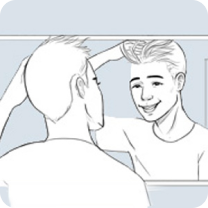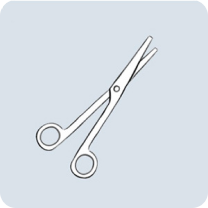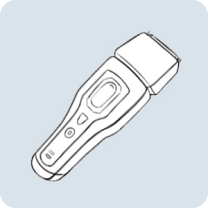Bandage: 24 hours
After 24 hours, it is time to remove the bandage over the donation area. If it lasts longer than 24 hours, there is a risk of infection.
After a hair transplant, it is important that you follow the aftercare instructions to get the best possible results. For your convenience, we have summarised the most important points on what to consider after your hair transplant. Here you can see a timeline of when you can start doing certain things again, such as exercising, using your hat and when you can start sleeping as normal.
Download information sheet
After 24 hours, it is time to remove the bandage over the donation area. If it lasts longer than 24 hours, there is a risk of infection.

You can start sleeping as usual 2 days after your hair transplant. Now the hair follicles have taken root and you don’t have to worry about causing any harm while you sleep. Read more about how to sleep the first few days after the procedure

72 hours after your hair transplant, you should start washing the newly transplanted hair with lukewarm water. After 4 days you can start washing your hair with a mild shampoo.

You can start wearing your hat and cap 5 days after your hair transplant, but only for short periods. You can start wearing a helmet after one month.

After 14 days, the healing process has progressed to the point where you can start using styling products on your hair.

The hair follicles have grown sufficiently strong for you to start practising again 14 days after the hair transplant.

4 weeks after the procedure, you can start sauna bathing again without the hair follicles being damaged by the heat. You can also swim in the public pool, in the sea and in the hot tub.

After 4 weeks, the transplanted hair can be trimmed but not shorter than 3 mm. If you trim your hair with a trimmer, it is important to use plastic covers to protect the transplant area. The rest of the hair and the donation area can be cut however you like. 4 weeks after your operation, you can also dye the newly transplanted hair.

Strong sunlight should be avoided for 6 months after your hair transplant. If you want to sunbathe, you can do so after 2 weeks if you cover the transplanted area carefully with a cap or headscarf. After 6 months, you can sunbathe as usual.

The transplanted area must not be shaved for the first 6 months. You can then start shaving your hair with a razor or using a razor blade. If you shave before 6 months have passed, you risk causing damage to the transplanted hair follicles.
The most critical time is the first 2-3 days when the area is at its most sensitive. The first week you should be extra careful.
After 2 weeks it is okay to start practicing, but you should still be a little careful with the sun and be vigilant so that the transplanted hair is not scratched.
After 3 weeks, you can generally do most everyday things, but avoid things like kicking a football, wearing a helmet or shaving with a razor.
We are always on hand to answer questions about aftercare.
Kabintrycket på flygplanet kan få svullnaden att gå upp men det lägger sig oftast efter en dag eller två.
You will be given a low dose of antibiotics for the first 3 days after your hair transplant to reduce the risk of infection.
This is not a normal course of antibiotics and the dose is very low. A total of 4 pills are taken.
To remove the scabs as gently as possible and to keep the area clean, we recommend standing in the shower for 10 minutes. Do not wash the area longer than this.
10 minutes is enough to soften the scabs and help them fall off naturally. Repeat this every day until all the scabs have fallen off.
Use hot enough water so that it is comfortable to stand in the shower for 10 minutes. Do not shower your hair in cold water.
The most important thing is that you can wash your hair in peace and let the scabs soften.
"Can you transplant hair from someone else? How does a PRP treatment work?" By following us on Instagram you will get answers to interesting questions and insights into the world of hair transplants and PRP treatments!
nordichairclinic